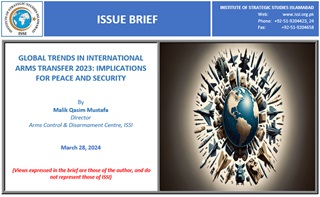In March 2024, the Stockholm International Peace Research Institute (SIPRI) released another significant ‘Fact Sheet’ highlighting a comparative analysis of trends in international arms transfer from 2014-18 to 2019-23.[1] The fact sheet reveals highly alarming trends in arms exports and imports. It is estimated that arms imports by Europe increased by 94 percent. Imports by Asia, Oceania, and the Middle East increased tremendously as “nine of the 10 biggest arms importers in 2019–23, including the top 3 of India, Saudi Arabia, and Qatar, belong to Asia and Oceania or the Middle East.”[2] Due to the ongoing conflict, Ukraine rapidly moved to fourth place with a global share of 4.9 percent of arms imports. It is estimated that it received major arms from more than 30 states during 2022–23. Pakistan came in the 5th position with a total share of arms imports of 4.3 percent as compared to 2.9 during 2014-18. The Fact Sheet also indicates that from 1999-2003 onwards, arms transfer is gradually increasing as states are interested in acquiring more weapons. This reflects that to maintain peace and security states are relying on armaments and they are constantly engaged in upgrading and modernizing their armed forces.
Home ISSI Publications Articles Issue Briefs Issue Brief on “Global Trends in International Arms Transfer 2023: Implications for...















